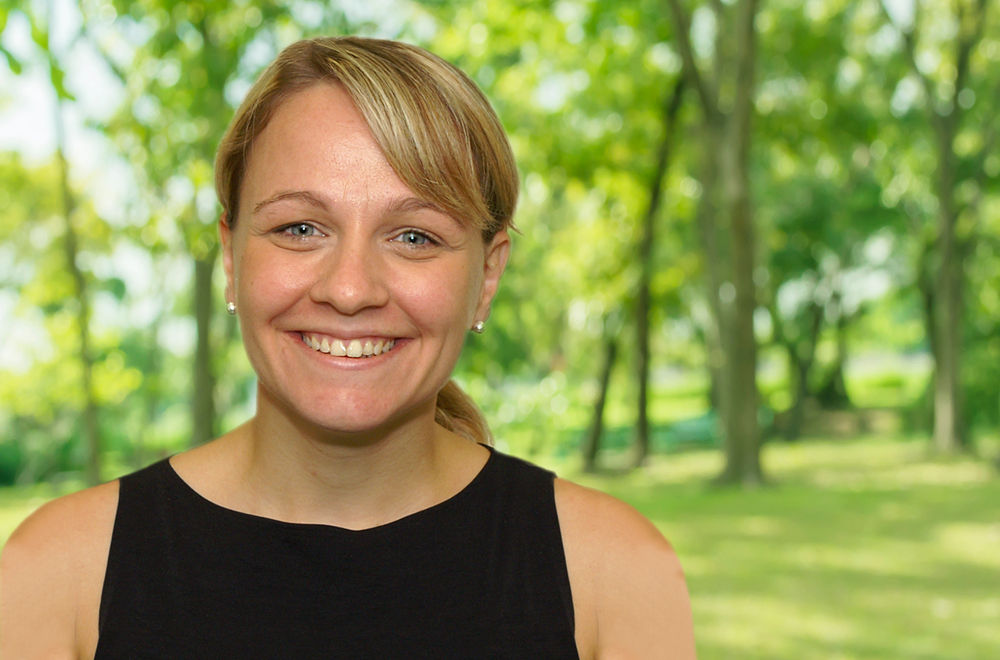Janine Latham, GISP, a Weston employee-owner of 18 years, currently serves as our Geospatial Technical Director and Geospatial Strategy Leader. Alongside Weston’s strategic business partner Esri, she is spearheading our Geospatial Strategy to transform business operations by unlocking the innovative power of geospatial technology. Janine leads a team of experts, Weston’s Geospatial Community of Practice, to execute this strategy. The team leverages innovative technologies, client and market needs, and internal capabilities to the benefit of our clients and the environment.
Janine earned two Bachelor of Science degrees in Earth Sciences and Environmental Resource Management at The Pennsylvania State University (Penn State), where she minored in Geographic Information System (GIS) for both programs. After college, Janine began her career as a GIS Analyst supporting and leading field events, which offered her a substantive learning experience on operational practices. She has led geospatial data management, including real-time data capture and visualization, for time-critical projects to address some of the nation’s largest natural disasters. Her expertise and innovative approaches over the course of her career advanced her to the Geospatial Technical Director role in 2017.
What does “geospatial” mean, and how does it apply to the environmental market?
The term “geospatial” has more frequently been used to describe emerging applications of advanced, web-enabled technologies such as GIS, GPS, and remote sensing. Traditionally, GIS specialists have generated, managed, analyzed, and mapped spatial data to create a flat map of a project area that is static in time. Now, we are seeing geospatial technologies become more effective in the decision-making process because they allow GIS specialists, scientists, and engineers alike to interact with the dynamic data in real time.
In the environmental market, the relationship between data and location drives most decisions throughout the project life cycle. Our Geospatial Strategy identifies the best data as spatially enabled, attributed for increased situational awareness, and narrowed to geographically related information. In our culture of data overload, with web-based platforms for data and analytics, we cut out the noise using our Geospatial Strategy to provide our clients with the best real-time, interactive data.
How are Weston’s clients using geospatial strategies to address their needs?
Our clients are adopting geospatial strategies to promote visualization for decision making and meaningful sharing of data with stakeholders. Because emerging technology is disruptive to businesses, as demonstrated by the rapid pace of geospatial innovation, our clients recognize the need to be prepared for operational shifts. With our Geospatial Strategy already in place, Weston can help them achieve continued success of GIS use throughout project execution.
Over the last 5 years, we have witnessed a revolution in geospatial technology and data accessibility. This revolution has enabled our clients and their stakeholders to integrate site-specific data with open data in 3D and 4D. Through a strategic geospatial approach, our clients have deepened their understanding of environmental issues at hand. The increased and improved information leads to more efficient decision making, underscoring the mission criticality of geospatial strategies and GIS use in all environmental projects.
Specifically, Weston’s clients use geospatial strategies for:
- Analytics/KPIs
- Public and Stakeholder Communications
- 3D Modeling and Visualization
- Field Mobility
- Geodesign Planning for Resiliency
- Project Digital Transformation
- Project Completion Catalyst and Delivery
- Drone Data Management and Analysis
What should Weston’s clients consider when deciding on a geospatial solution for their needs?
First, our clients should consider pivoting their initial focus from technology to Data Quality Objectives (DQOs) to get them to project completion. For example, in remediating a site, our clients may ask, “What data do we need to solidify and expedite project planning, operations, and completion?” They can position themselves well by collecting the best data (spatially enabled, attributed, and narrowed) and/or exploring external sources, which will reinforce their decision-making process and fast-track project delivery. However, I’d caution our clients away from information overload. Accounting for every piece of data and all its attributes will only create noise and slow down project delivery.
Once our clients have established DQOs, necessary operations, and reporting requirements, they can apply the same decision-making process to technology. They can evaluate the most effective and usable technology from a wide selection—without, of course, being distracted by the “bells and whistles.” To successfully deliver a project, our clients should prioritize technology that drives operational excellence over flashy, new options.
What advice do you have for geospatial professionals working to transform their companies in the digital economy?
- Don’t be afraid of change or the risk in creating change. Geospatial technology isn’t going to wait for you to get comfortable—it will always be quickly evolving.
- Create, collaborate, and empower a TEAM! You’re never going to do this alone. Lead that team with a vision and promote imagination.
- Establish partnerships inside and outside the company—external partnerships could include technology companies, organizations, and clients.
- Put a strong focus on the people that this transformation will support—with energy, purpose, and a plan. Give them the opportunity to dream about the positive impacts this transformation may cause and support them with tools and strategies.
- Be passionate. You must love and understand the power in using geospatial technology as a means of progressing your organization to best in class.
Where do you see the need to be adaptable, and how does Weston’s Geospatial Strategy support those areas?
Due to the state of the world, climate change, and the need for resiliency planning, the stakes are high. More than ever before, Weston’s execution of our Geospatial Strategy is critical for these current areas. We have developed this strategy around our employee-owners to support our clients’ goals and community needs for environmental advancement. I look forward to the continual growth of our company being at pace with, if not ahead of, the evolution of geospatial solutions and technologies.
More about our Expert:
What initially drew you to the geospatial field?
I grew up in a large and very close family and community. We were constantly surrounded by positive examples of curiosity in the sciences and community service. My dad is a (retired) chemist (as is my sister) and ran the chemical R&D laboratory at a steel mill, and my mom and many others in our family are teachers. They were strong role models, not just at my school, but within our faith community, as well. In fact, they started the science fair at my small, local grade school in which my sister and I participated in every year.
As we got older, we accompanied my dad to his R&D laboratory on Saturdays to work on our school projects. We used high-precision scales, Bunsen burners, and spectrophotometers. From 6th grade through high school, I became more fascinated in environmental issues and incorporated these issues into a science fair topic, such as the environmental effects of burning fossil fuels.
When it was time to go to college, I knew I wanted to pursue a career in the environmental sciences that combined my passion for science and desire to serve my community. I first pursued a degree in Earth Sciences within Penn State’s College of Earth and Mineral Sciences before adding a second degree in the College of Agricultural Sciences for Environmental Resource Management. While in school, I loved being in nature and learning and experiencing the world around me. I found the beauty in our earth and its connections—that’s where GIS comes in! So, while pursuing those degrees, I began some courses in GIS and became transfixed.
I saw the science behind the where, how, and why, and it was beautiful and inspiring. I saw where geospatial technologies like GIS connects all of us and all things. Learning how to better our environment and communities using science and technology in the most visual way—who wouldn’t want to work in that every day?
What has been the most important development in your career at Weston?
The turning point in my career was deciding to go support our firm’s Superfund Technical Assessment and Response Team (START) contract in the aftermath of Hurricane Katrina. At the time, I was working out of our West Chester, PA office when I responded to a company-wide email to assist our Hurricane Katrina START for 2 weeks. I remember thinking, What can I do to help? We had all seen the devastating footage of the previous day’s events. When I got the call to pack my bags, I found myself heading to Walmart to get a sleeping bag and nonperishable food instead of attending a Phillies game with my parents. I was scared, nervous, and excited all at the same time.
A 2-week tour turned into 9 months of working around the clock in less-than-ideal living conditions among 300 members of my new Weston family. I went from being a GIS Analyst in a four-person team to leading a 24-hour GIS unit of up to 24 analysts, coordinating and working with the U.S. Environmental Protection Agency (EPA) and their response partners. I made lifelong professional and personal relationships while growing and learning invaluable lessons on teaming, leadership, and compassion.
My Hurricane Katrina experience opened my eyes to the power of geospatial data-driven operations and became the steppingstone on which I have built my career at Weston. Through emergency response support, I truly experienced the value of working as a team, relying on one another to get the job done efficiently to ensure the public and fellow team members’ health and safety. These micro-opportunities for growth have given me the vision to provide our employee-owners and clients with the latest geospatial tools and strategies to create a better environment. My biggest takeaway? You can only experience growth personally and professionally by taking risks and identifying opportunities where you can make a difference and lead.

